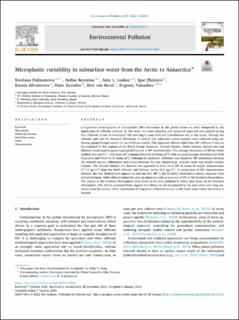| dc.contributor.author | Pakhomova, Svetlana | |
| dc.contributor.author | Berezina, Anfisa | |
| dc.contributor.author | Lusher, Amy L. | |
| dc.contributor.author | Zhdanov, Igor | |
| dc.contributor.author | Silvestrova, Ksenia | |
| dc.contributor.author | Zavialov, Peter | |
| dc.contributor.author | van Bavel, Bert | |
| dc.contributor.author | Yakushev, Evgeniy | |
| dc.date.accessioned | 2022-03-17T12:30:18Z | |
| dc.date.available | 2022-03-17T12:30:18Z | |
| dc.date.issued | 2022 | |
| dc.identifier.citation | Environmental Pollution (1987). 2022, 298, 118808. | en_US |
| dc.identifier.issn | 0269-7491 | |
| dc.identifier.uri | https://hdl.handle.net/11250/2985853 | |
| dc.description.abstract | Comparative investigations of microplastic (MP) occurrence in the global ocean are often hampered by the application of different methods. In this study, the same sampling and analytical approach was applied during five different cruises to investigate MP covering a route from the East-Siberian Sea in the Arctic, through the Atlantic, and into the Antarctic Peninsula. A total of 121 subsurface water samples were collected using underway pump-through system on two different vessels. This approach allowed subsurface MP (100 μm–5 mm) to be evaluated in five regions of the World Ocean (Antarctic, Central Atlantic, North Atlantic, Barents Sea and Siberian Arctic) and to assess regional differences in MP characteristics. The average abundance of MP for whole studied area was 0.7 ± 0.6 items/m3 (ranging from 0 to 2.6 items/m3), with an equal average abundance for both fragments and fibers (0.34 items/m3). Although no statistical difference was found for MP abundance between the studied regions. Differences were found between the size, morphology, polymer types and weight concentrations. The Central Atlantic and Barents Sea appeared to have more MP in terms of weight concentration (7–7.5 μg/m3) than the North Atlantic and Siberian Arctic (0.6 μg/m3). A comparison of MP characteristics between the two Hemispheres appears to indicate that MP in the Northern Hemisphere mostly originate from terrestrial input, while offshore industries play an important role as a source of MP in the Southern Hemisphere. The waters of the Northern Hemisphere were found to be more polluted by fibers than those of the Southern Hemisphere. The results presented here suggest that fibers can be transported by air and water over long distances from the source, while distribution of fragments is limited mainly to the water mass where the source is located. | en_US |
| dc.language.iso | eng | en_US |
| dc.publisher | Elsevier | en_US |
| dc.rights | Navngivelse 4.0 Internasjonal | * |
| dc.rights.uri | http://creativecommons.org/licenses/by/4.0/deed.no | * |
| dc.title | Microplastic variability in subsurface water from the Arctic to Antarctica | en_US |
| dc.type | Peer reviewed | en_US |
| dc.type | Journal article | en_US |
| dc.description.version | publishedVersion | en_US |
| dc.rights.holder | © 2022 The Authors. | en_US |
| dc.source.volume | 298 | en_US |
| dc.source.journal | Environmental Pollution (1987) | en_US |
| dc.identifier.doi | 10.1016/j.envpol.2022.118808 | |
| dc.identifier.cristin | 1987454 | |
| dc.source.articlenumber | 118808 | en_US |

